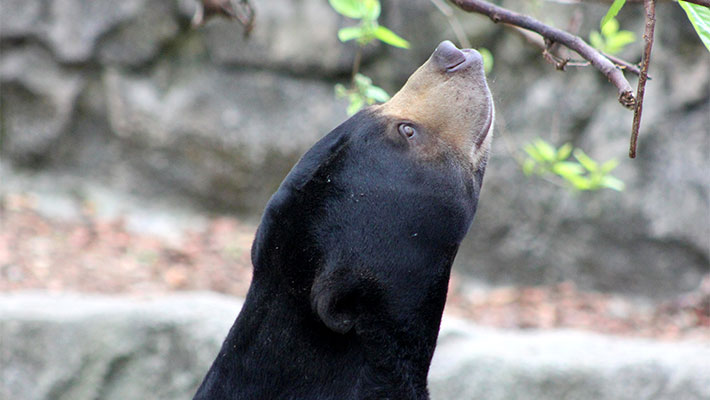A rare bear
Sun Bears are one of the world’s rarest species of bear. They are the only truly tropical bear and are one of only two bears that live south of the equator. They are also the world’s smallest bear standing at around 1.5m high.
Not a teddy bear
Sun Bears are shy and intelligent but don’t be fooled by their ‘teddy bear’ looks. Sun Bears are fierce. They will fight off tigers, leopards and large pythons when threatened.
Dressed to impress
Each and every Sun Bear has a unique U-shaped golden crest on its chest resembling the rising or setting of the sun. No two ‘sun’ markings are the same. The ‘hela’ in their scientific name means ‘the heart of the sun’.
Pawfection
With specialised 7.5cm claws on large paws, Sun Bears are wonderfully adapted for life up high. Their enormous curved claws and hairless paws make for exceptional climbing and ripping open trees, bark and rotten logs in search of food.
The bear necessities
Sun Bears have a toolbox of amazing adaptations that help them survive:
- At 25cm their long probing tongues make excellent honey trappers and grub catchers
- Short, sleek, black coat to avoid overheating in tropical weather but thick and coarse to provide protection from branches, twigs and rain
- Loose, wrinkly skin means if they are grabbed or bitten they can turn in their skin and bite back at their attacker
- A strong jaw for crushing and biting down on branches and coconuts
- Sun Bears bark, growl and roar to scare away predators and declare territory. Friendly intent for mating resembles the noise of a hen clucking
Bearly hanging on
Threats to Sun Bears survival in the wild:
- Extreme habitat loss and illegal wildlife trade for the pet industry, for use in gourmet cuisine and traditional medicine continues to threaten the survival of bears in SE Asia. Large scale deforestation, logging and conversion of forest to agricultural land have destroyed much of the Sun Bear’s habitat. The creation of logging roads has also provided convenient access for poachers. Sun Bears are often captured from the wild to be kept as pets, the mother bear being killed in order to obtain cubs young enough to tame. Sun bears will also eat farmed crops such as coconuts and oil palms which leads them into conflict with the farmers
- Bear Paw Soup is considered both a "tonic" food and a gourmet delicacy - consumers flaunt their wealth by buying it for themselves and their guests. Bear products and meat are served openly at restaurants throughout Asia and available through black markets around the world
- It is estimated that around 14,000 bears are caged in bile extraction facilities across Asia to meet high demand for bear bile medicines. Many of these bears were taken from the wild as wild sun bear bile is 30% more potent in ursodeoxycholic acid than the captive Sun Bears

Come and meet us
Meet our Sun Bear Mary at Taronga Zoo Sydney